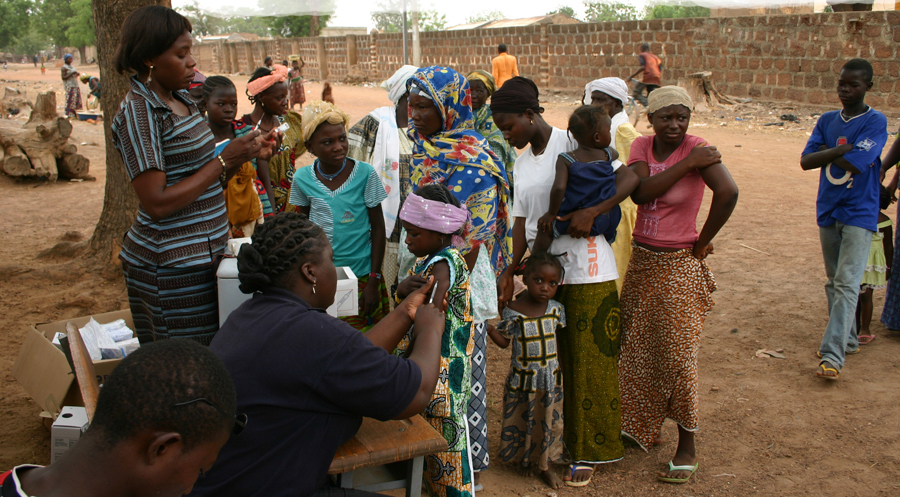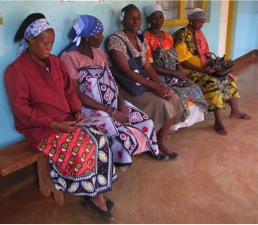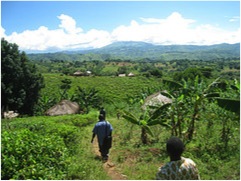
Health Care Education for Women means a Brighter Future for All
— World Health Organization Constitution
By Donna Shaver
If a country is to be successful economically, both health care and education are required. For many countries in the developing world, these preconditions have not been met— especially in the rural areas. Few villages have any skilled medical personnel nearby; many do not even have a road, and the nearest medical care may be a rural clinic that is poorly staffed, poorly equipped, and many miles away.
Similar problems arise with education. Not every village has a school, school fees and uniforms are required for participation, and girls especially are needed at home to help their mothers haul water, gather firewood, attend younger children, and cook and clean. Mothers often work in the fields for long hours to earn a living and put food on the table. If education is available, boys’ education is a priority. Girls are often taken out of school, sometimes before they have a chance to complete elementary school, and married off—for the bride price, by custom, and/or to reduce the number of mouths to feed.
Linking Health and Education
The causes and consequences of poor health care and lack of education are inseparable. When health care is not readily accessible, diseases go undiagnosed and untreated. Women seldom have pre-natal care and lack the services of a skilled birth attendant — conditions that lead to maternal death or childbirth injury, unhealthy babies, and high infant mortality rates. The death of a mother has profound repercussions that further reduce the life chances of any other children and may bankrupt the family in the process.
If a parent is in poor health as a result of disease or disability, or dies of preventable or treatable disease such as AIDS, malaria, or tuberculosis, the consequences may be very similar. The younger children will most likely not have an opportunity to attend school and school-age children may be forced to drop out to help at home. In any case, the family will not be contributing to the economy, and poverty and lack of education are perpetuated.
Our June 2014 Dining for Women recipient organization – the Tanzania Nursing Scholarship Program – addresses both health care and education through its Nursing Scholarship Program Supplement.
By providing nursing scholarships to promising girls from poor areas, it enables girls who would otherwise have no opportunities beyond secondary school to gain the professional health skills so desperately needed in their own communities. Because of their skills and commitment, they will become highly valued within their society, and role models for girls.
Investing in Health
— The Lancet, December 2013, “Reinvesting in health post-2015”
In order to achieve the benefits The Lancet extolls, developing countries need to invest in training more health professionals and be certain they are widely distributed across the country to serve both urban and rural areas. According to a 2010 Bulletin of the World Health Organization, India alone would have required 2.4 million nurses by 2012 in order to have a nurse-patient ratio of 1 to 500. A large part of the problem is the lack of nurse training programs and faculty to staff them.
When we think about health issues in developing countries, we most often consider malaria, HIV/AIDS, tuberculosis, and maternal health issues. But an article in the May 2014 issue of The Lancet, “Readiness of the primary care system for non-communicable diseases in sub-Saharan Africa”, noted that chronic non-communicable diseases are the second leading causes of death in Africa. These include stroke, hypertensive heart disease, diabetes and chronic kidney disease. The prevalence of non-communicable disease also factors into the need for more medical personnel.
Retaining health care providers
An additional problem for many developing countries is in retaining their nurses. Qualified nurses can find employment in Europe, Canada and the United States that gives them much higher salaries and more opportunities. In 2007, the American Journal of Public Health noted that the major source countries for foreign-trained nurses in the U.S. were the Philippines, India, Canada, and South Korea. Both the Philippines and India are developing countries. An estimated 20,000 health care professionals in Africa emigrate each year. So the nursing shortage in developed countries further exacerbates the shortage of nurses in developing countries.Although the gold standard would be to have an adequate number of trained physicians and nurses to serve the population of a country – rural as well as urban – developing countries do not have the resources. In most developing nations, much of the country is rural, villages are scattered, and hospitals and clinics few and far between. It is difficult to hire doctors and nurses willing work in these settings. Authors of the article “The Nigeria health sector and resource challenges”, report that attrition rates for doctors in rural areas are three times and for nurses two times higher than for urban areas. “Doctors and nurses are reluctant to relocate to remote areas and forest locations that offer poor communications with the rest of the country and few amenities for health professionals and their families.”
Community Health Workers
The statistics are clear for the developing world: There are not enough doctors and nurses to provide adequate care for everyone. Rural areas are especially underserved—and much of the developing world is rural. It is impossible to deploy such limited resources to meet the needs on the ground without a consistent network of health care providers. One growing trend in the developing world is the training and deployment of Community Health Workers (CHWs)—although the name, skill set, or services provided are as yet standardized worldwide. CHWs are the link between individuals and families with health care needs and the formal health care system, and some of these programs have been operating for decades. The World Health Organization and Global Health Workforce Alliance completed a major study on Community Health Worker programs with regard to the UN Millennium Development Goals, which included reviews of specific programs, including the following two:
- Pakistan has huge public sector program for training and deploying Lady Health Workers (LHWs). It has been in place since 1994 and now covers over 70 percent of the rural population with a work force exceeding 90,000.
- Ethiopia’s Health Extension Program started in 2004 and trains Health Extension Workers, which are all female. They are selected by their communities. They promote health, provide preventive health care and selected medical services. Two workers are deployed to every village with a population of 5,000, and they are supported by volunteer CHWs selected by the community. There are currently some 38,000 extension programs.
In January 2013, Rwandan President Paul Kagame, Novartis CEO Joseph Jimenez and Professor Jeffrey Sachs, Director of the Earth Institute, announced the One Million Community Health Workers campaign to recruit, train, and deploy one million CHWs in Sub-Saharan Africa. Rwanda already has 15,000 Community Health Workers to provide access to health care for all rural areas. Much of the effort has gone toward maternal health. These workers educate mothers and families on basic health, and maternal and newborn care. Mama Jean, has only a sixth grade education, but she is an effective health worker, as evidenced by the fact that maternal and newborn deaths in her community have decreased significantly since she has been working.
The level of training, skills, expectations, and oversight varies from program to program. Community Health Workers usually live in the communities they serve, and are often either selected by the community or community leaders, or recruited from the village. According to the World Health Organization, the evidence is overwhelming that such community-based interventions are highly effective in reducing mortality and disease, improving immunizations and access to higher-level care, and providing low-cost interventions for common health problems.
Cost of Community Health

Community health workers are often involved with preventative measures, such a educating the community on using mosquito bed nets, immunizations, sanitation, hygiene and the diagnosis/referral for diagnosis and treatment of HIV-AIDS, tuberculosis, and other diseases. They treat diarrhea, a major killer of small children. A special focus is on maternal health. This includes being aware of which women in the community are pregnant, and ensuring pre-natal care and nutrition, appropriate care for delivery, and the means to access transportation and higher levels of medical care for maternal emergencies. They also provide post-natal care such as assistance with breast feeding, and monitor newborns for any health issues.
Women and the War on Tropical Diseases
Most developing countries are in sub-Saharan Africa or South Asia. Sub-Saharan Africa is especially plagued with tropical diseases that cause long-term health issues, loss of productivity, or death. The Carter Center has taken on the battle against these lesser-known afflictions, particularly guinea worm and trachoma. A Call to Action: Women, Religion, Violence, and Power, by former president Jimmy Carter tells the story of how the Carter Center has enlisted mostly women in determining causes of, and responses to, tropical diseases. The results are astounding:
Guinea worm disease is spread by ingesting the larvae of this debilitating parasite in contaminated water. The disease incapacitates victims for long periods of time, creating a serious impact on productivity and quality of life.
The eradication project began in 1990 and since then, 131 women have served as technical advisors – most of them have master’s degrees in public health. The extensive surveys required to find cases have involved thousands of women. Education is needed to teach people to avoid or filter contaminated water. Women also participated in the education process by writing original plays and songs to explain how to use a filter, and printed cartoon instructions on cloth.
In 1986, according to the Carter Center, the disease affected an estimated 3.5 million people a year in 21 countries in Africa and Asia. Guinea worm disease is nearly eradicated now with nearly all of the remaining cases — just 113 in 2013 — in South Sudan. Much of the credit for this goes to a large, dedicated cadre of women.
Trachoma is a bacterial infection of the eye is caused by poor hygiene and easily spread from human to human. A painful condition called trichiasis – scarring and inward turning of the eyelid – results from repeated infection, and if left untreated, leads to blindness. It is second only to cataracts as a cause of blindness, and according to the Carter Center, affects tens of millions of the world’s poorest people. Several thousand health workers, mostly women, educate villagers on hygiene, and distribute antibiotics. Over a hundred million doses have been given out. Many of these women have been taught to perform the eyelid surgery to correct the effects of trachoma, and these workers perform about 40 percent of the operations in the world.
In terms of threats to their health, women and children are the most vulnerable segments of the population. In terms of responding to those threats in the developing world, women are also on the frontlines of health care and health education. The nurses whose educations Dining for Women will support in Tanzania will not only save lives and provide critical health services – they will be advocates and role models for the women and girls they serve.
—Dr. Paul Farmer

